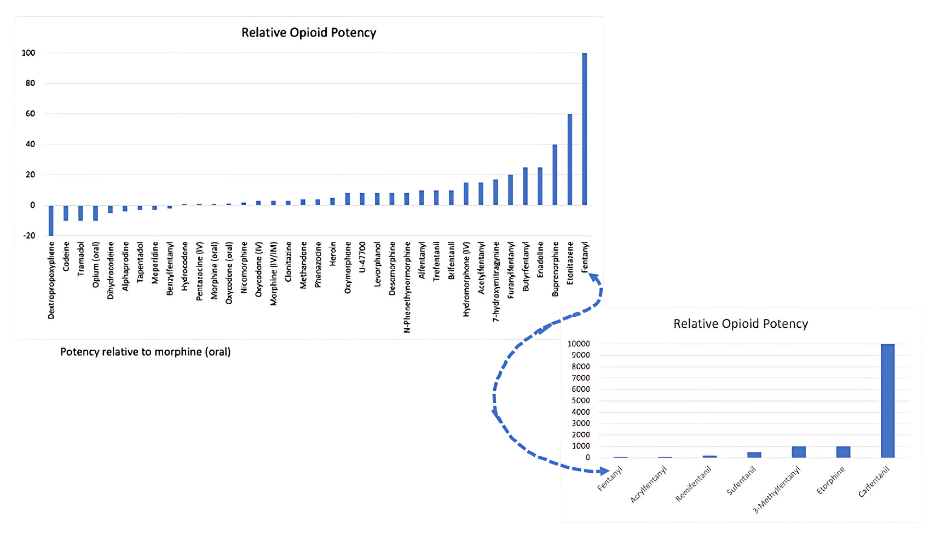By Sabra Jones and Chris Heartsill, Regional Toxicology Liaisons, National Highway Traffic Safety Administration, Regions 5 and 7
Per the Centers for Disease Control, overdose deaths remain the leading cause of injury-related deaths in the United States1 and fentanyl and fentanyl analogs, play a major role in the opioid epidemic.
Fentanyl, a man-made or synthetic drug with properties like opiate drugs such as morphine and heroin, is primarily used medically to manage severe pain, especially in cases where other opioids may not be effective. While opioid potency varies greatly, fentanyl is estimated to be 50 to 100 times more potent than morphine and significantly more potent than heroin (figure 1). In 2021, there were more than 100,000 drug overdose deaths with 75% related to opioids. Of these, 82% of deaths were due to the use of synthetic opioids, such as fentanyl and fentanyl analogs in addition to other similar compounds2.
A fentanyl analog is a substance that is structurally similar to fentanyl but may have variations in chemical structure. These compounds have similar pharmacological effects, including pain relief and analgesia. Fentanyl analogs have different potency levels, durations of action and side effect profiles compared to fentanyl. Some analogs, such as carfentanil, can have a potency of up to 10,000 times more potent than morphine and 100 times more potent than the parent compound fentanyl, increasing the risk of overdose4. Some fentanyl analogs have existed for decades and have or had medical uses, whereas non-pharmaceutical analogs are increasing in prevalence and use. These compounds include sufentanil, alfentanil, remifentanil, carfentanil, α-methylfentanyl, 3-methylfentanyl, acetylfentanyl, furanyl fentanyl, butyrylfentanyl, acrylfentanyl, furanylfentanyl and β-hydroxythiofentanyl, and more. Further, N-phenyl-1-(2-phenylethyl) piperidin-4-amine (4-ANPP) has been designated by the Drug Enforcement Administration (DEA) as an intermediate chemical precursor used in the synthesis process for the illicit production of the schedule II controlled substance, fentanyl, and other related opioids3

Figure 1. Relative Opioid Potency
Illicitly produced fentanyl analogs have been a major concern in the context of the opioid epidemic, as they contribute to the increased risk of overdose and death. Authorities work to monitor and regulate these substances to address the public health risks associated with their use. The diversity in fentanyl analogs poses a challenge for forensic and clinical testing, workplace drug testing, public health officials, law enforcement and consumers as new variations emerge coupled with their varying legal statuses. An additional complicating factor is the combination of fentanyl with other drugs such as xylazine, methamphetamine, cocaine, methylenedioxymethamphetamine (MDMA), and other opioids. In many cases users may be unaware that the drugs they are consuming contain these extremely potent combinations and may include counterfeit pills mimicking legitimate therapeutic drugs5.
Testing of biological matrices such as blood, urine, oral fluid, etc. that may contain fentanyl and/or fentanyl analogs can be challenging. Depending on the scope of testing of a laboratory, these analytes may or may not be detected. Further, if a laboratory is utilizing an immunoassay test for presumptive or screening purposes, unless the test kit is specific for fentanyl, it will not detect these compounds. Therefore, laboratories would need a more specific test such as the use of mass spectrometry coupled with chromatography (i.e., GC-MS, LC-MS, LC-MS/MS, LC-TOF, etc.). As new, and emerging fentanyl analogs become available to consumers, testing laboratories must rely on analytical techniques such as high-resolution mass spectrometry to elucidate these compounds and expand their testing capabilities. Even in cases of fentanyl and fentanyl analog overdose, the concentration of these compounds can be extremely low and may be lower than the analytical capabilities of the testing laboratory.
As the opioid epidemic continues, employers and workplace drug testing laboratories must remain vigilant in the extreme impairment risks associated with the use of fentanyl, fentanyl analogs and the mix of these with other drugs.
- Understanding Drug Overdoses and Deaths. Centers for Disease Control. https://www.cdc.gov/drugoverdose/epidemic/index.html (Accessed November 30, 2023)
- Ahmad FB, Sutton P. Provisional drug overdose death counts. 2021. https://www.cdc.gov/nchs/nvss/vsrr/drug-overdose-data.htm (Accessed November 30, 2023)
- Schueler HE. Emerging Synthetic Fentanyl Analogs. Acad Forensic Pathol. 2017 Mar;7(1):36-40. doi: 10.23907/2017.004. Epub 2017 Mar 1. PMID: 31239954; PMCID: PMC6474477.
- Jalal H, Burke DS. Carfentanil and the rise and fall of overdose deaths in the United States. Addiction. 2021 Jun;116(6):1593-1599. doi: 10.1111/add.15260. Epub 2020 Sep 25. PMID: 32935381; PMCID: PMC8019064
- Drug Fact Sheet, Counterfeit Pills. Drug Enforcement Agency. https://www.dea.gov/sites/default/files/2021-05/Counterfeit%20Pills%20fact%20SHEET-5-13-21-FINAL.pdf (Accessed December 7, 2023)
